Agent Street: An Environment for Exploring Agent-Based Models in Second Life
Journal of Artificial Societies and Social Simulation
12 (4) 10
<https://www.jasss.org/12/4/10.html>
For information about citing this article, click here
Received: 17-Dec-2008 Accepted: 12-Jul-2009 Published: 31-Oct-2009
 Abstract
Abstract

|
| Figure 1. Prims—The Basic Building Blocks of Second Life |
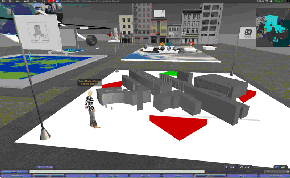
|
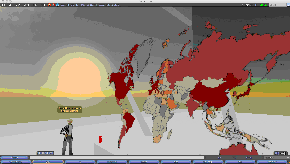
|
| A | B |
|
Figure 2. Iconic Models within Second Life: Visualisation of Data. A: Importing and Visualising Virtual Cities. B: Visualising Geographical Data | |

|
| Figure 3. Agent Street: Agent-based Models in Second Life |

|
| Figure 4. Model Vending Machines: By Touching the Machines Visitors can Download and Save the Models |
 |
 |
| Initial Condition | T1 |
| Block Pattern (Static Pattern) | |
 |
 |
| Initial Condition | T1 |
| Blinker Pattern (Oscillator) | |
 |
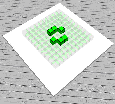 |
| Initial Condition | T1 |
| Toad Pattern (Oscillator) | |
 |
 |
| Initial Condition | T1 |
| Glider Pattern (Spaceship) | |
 |
 |
| Initial Condition | T1 |
| Lightweight Pattern (Spaceship) | |
| Figure 5. Examples of Patterns From the Game of Life | |
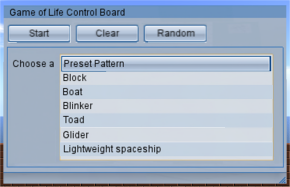
|

|
| A | B |
|
Figure 6. The Game of Life Model in Second Life A: Allowing the User to Select a Preconfigured Distribution of 'Alive' Cells From the Control Panel. B: User Starting with a Blank Canvas which 'Alive' Cells can be Added | |

|
| Figure 7. An Example of Satisfied and Dissatisfied Agents (Satisfied Agents are the Larger Circles) |

|
| Figure 8. The Evolution of Segregation: Agents want to Live in Neighbourhoods where 50% or More are Like Themselves (Small Circles Represent Dissatisfied Agents) |

|
| Figure 9. Schelling's Segregation Model within Second Life. With the Graph in the Background, the Checkerboard in the Middle and Control Panel in the Foreground |

|
| Figure 10. The Role of Preferences on the End Pattern of Segregation that Emerges |

|
|
Figure 11. Different Internal Room Configurations (A) Simple Room, No Obstacles; (B) Complex Room Layout, with Obstacles, and Internal Walls; A Two Story Floor Layout Connected by Stairs with Obstacles and Internal Walls (C=First Floor, D=Ground Floor) |

|
| Figure 12. Pedestrian Agents with Texture Mapped Features |
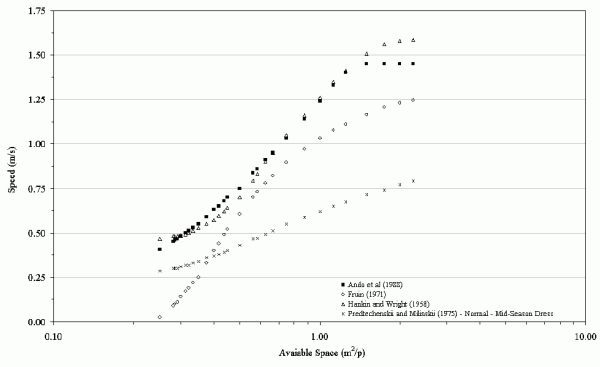
|
| A: Level Surface Walking Speed as a Function of Available Space |
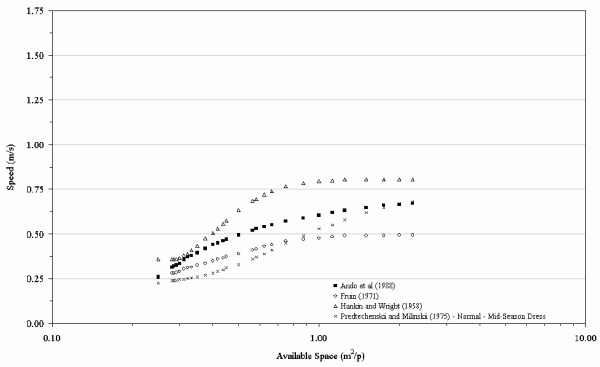
|
| B: Comparison Upstairs Walking Speed as a Function of Available Space |
| Figure 13. Comparison of Ando et al.'s (1988), Fruin's (1971), Hankin and Wright's (1958), and Predtechenskii and Milinskii's (1978) walking speed data as a function of available space. (Source: Castle 2007b) |

|
| Figure 14. Flow Chart of the Pedestrian Agent Key Processes Pertaining to Movement |

|
| Figure 15. Typical Simulation Results from PedTrace when all the Agents have Exited the Three Different Room Layouts |

|
| Figure 16. Agents reacting to Avatars |
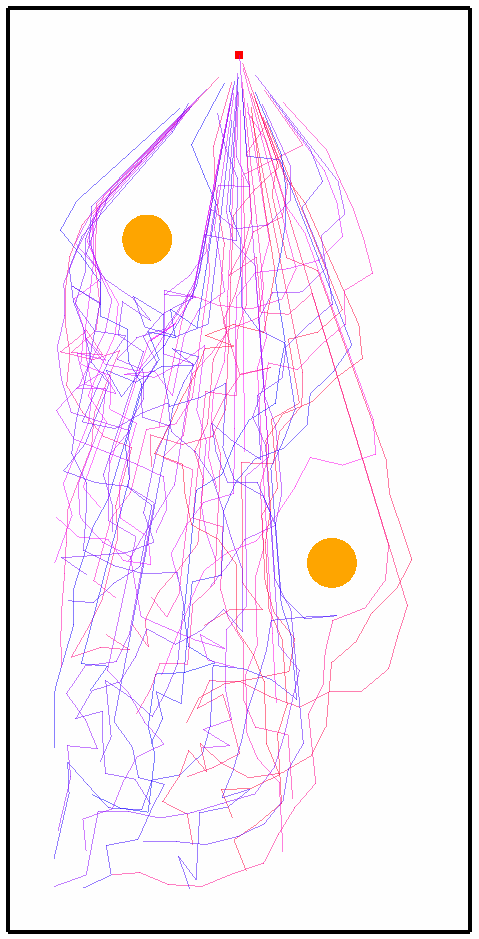
|
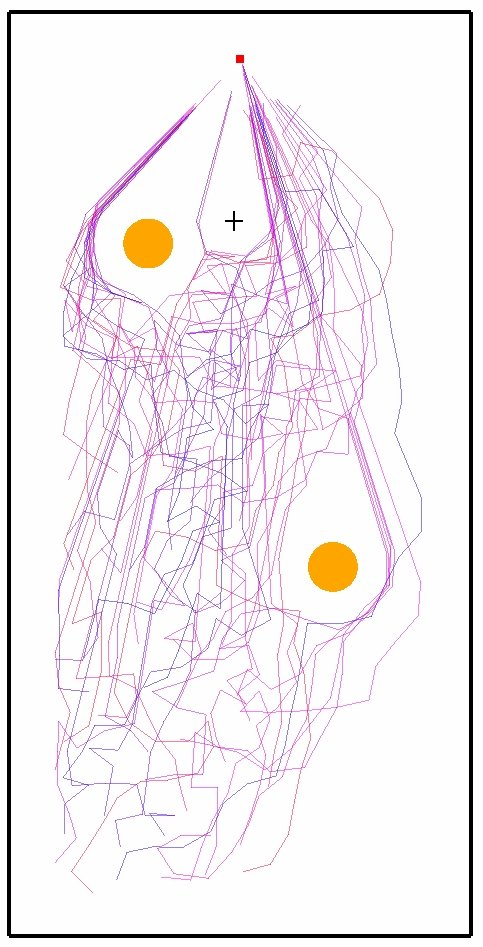
|
| A | B |
| Figure 17. Pedestrian Traces | |
2Agents only move to areas where they will be satisfied. If there are no suitable areas, the agent does not move. This only becomes an issue when segregation preferences rise above 90%.
3As an interesting side note, such interpersonal distance preferences have already been observed in virtual environments between avatars (see Yee et al 2007).
4The reader is referred to http://www.casa.ucl.ac.uk/abm/secondlife/ for animations and higher resolution images of these simulation results from the PedTrace application.
5To see this process occurring the reader is referred to the movies of multi floor simulation at http://www.casa.ucl.ac.uk/abm/secondlife
AVASTHI, A. (2006) Second Life: Other Virtual Worlds Reshaping Human Interaction. National Geographic. Available at http://news.nationalgeographic.com/news/2006/10/061017-second-life.html [Accessed on June 6th 2008].
AXELROD, R. (2007) Simulation in the Social Sciences. In Rennard, J.P. (Ed.) Handbook of Research on Nature Inspired Computing for Economy and Management. Hershey, PA: Idea Group. pp. 90-100.
BAINBRIDGE, W.S. (2007) The Scientific Research Potential of Virtual Worlds. Science. 317(5837): 472-476.
BATTY, M. (1976) Urban Modelling: Algorithms, Calibrations, Predictions. Cambridge, UK: Cambridge University Press.
BATTY, M. (2007) Model Cities, Town Planning Review, 78(2): 125-178.
BATTY, M. and Hudson-Smith, A. (2005) Urban Simulacra. Architectural Design. 75(6): 42-47.
BATTY, M., Steadman, P. and Xie, Y. (2006) Visualization in Spatial Modelling, in Portugali, J. (ed.) Complex Artificial Environments, Berlin, Germany: Springer, pp. 49-70.
BENENSON, I., Omer, I. and Hatna, E. (2002) Entity-Based Modelling of Urban Residential Dynamics: The Case of Yaffo, Tel Aviv, Environment and Planning B, 29(4): 491-512.
BERGER, H., Dittenbach, M., Merkl, D., Bogdanovych, A., Simoff, S. and Sierra, C. (2007) Opening New Dimensions for E-Tourism, Virtual Reality, 11(2-3): 75-87.
BROWN, D.G. (2006) Agent-Based Models. In Geist, H. (Ed.) The Earth's Changing Land: An Encyclopaedia of Land-Use and Land-Cover Change. Westport, CT: Greenwood Publishing Group. pp. 7-13.
BUCHANAN, M. (2006) A Grand Challenge: Social Simulation for a Healthier Internet. Available at ftp://ftp.cordis.europa.eu/pub/ist/docs/fet/7fp-30.pdf [Accessed on June, 24th 2008].
CASTLE, C.J.E. (2007a) Guidelines for Assessing Pedestrian Evacuation Software Applications. Centre for Advanced Spatial Analysis (University College London): Working Paper 115. London, UK.
CASTLE, C.J.E. (2007b) Agent-Based Modelling of Pedestrian Evacuation: A Study of London's King's Cross Underground Station. PhD Thesis. London, UK: University College London.
CASTLE, C.J.E. and Crooks, A.T. (2006) Principles and Concepts of Agent-Based Modelling for Developing Geospatial Simulations. Centre for Advanced Spatial Analysis (University College London): Working Paper 110. London, UK.
CASTLE, C.J.E. and Longley, P.A. (2008) Emergency Pedestrian Evacuation Analysis: A Review and Interpretation of Software Applications. In Sui, D.Z. and Cutter, S.L. (Eds.) Geospatial Technologies and Homeland Security: Research Frontiers and Challenges. Berlin, Germany: Springer. pp. 209-228.
CHEN, K.-T., Huang, C.Y., Huang, P. and Lei, C.L. (2006) An Empirical Evaluation of TCP Performance in Online Games. Proceedings of the 2006 ACM (Association for Computing Machinery) SIGCHI (Special Interest Group on Computer-Human Interaction) International Conference on Advances in Computer Entertainment Technology. Hollywood, CA. Available at http://portal.acm.org/citation.cfm?doid=1178823.1178830.
CROOKS, A.T. (2008) Constructing and Implementing an Agent-Based Model of Residential Segregation through Vector GIS. Centre for Advanced Spatial Analysis (University College London): Working Paper 133. London, UK.
CROOKS, A.T., Castle, C.J.E. and Batty, M. (2008) Key Challenges in Agent-Based Modelling for Geo-spatial Simulation. Computers, Environment and Urban Systems. 32(6): 417-430.
DODGE, M. and Kitchin, R. (2001) Atlas of Cyberspace, London, UK: Addison-Wesley.
EPSTEIN, J.M. (2007) Generative Social Science. Princeton, NJ: Princeton University Press.
EPSTEIN, J.M. and Axtell, R. (1996) Growing Artificial Societies: Social Science from the Bottom Up. Cambridge, MA: MIT Press.
FRUIN, J.J. (1971) Pedestrian Planning and Design. New York, NY: Metropolitan Association of Urban Designers and Environmental Planners.
GILBERT, N. (2007) Agent-Based Models. London, UK: Sage Publications Inc.
HACKATHORN, E.J. (2006) Designing an Educational Island inside Second Life for the National Oceanic and Atmospheric Administration (NOAA) Earth System Research Laboratory (ESRL). In D., L. and Kemp, J. (Eds.) Proceedings of the Second Life Education Workshop at the Second Life Community Convention, San Francisco, CA, pp. 12. Available at http://eric.ed.gov/ERICDocs/data/ericdocs2sql/content_storage_01/0000019b/80/1b/ef/03.pdf.
HANKIN, B.D. and Wright, R.A. (1958) Passenger Flow in Subways. Operational Research Quarterly. 9(2): 81-88.
HOFF, R. (2006) A Virtual World's Real Dollars, Business Week. Available at http://www.businessweek.com/technology/content/mar2006/tc20060328_688225.htm [Accessed on April 23rd 2008].
HOOGENDOORN, S.P. and Bovy, P.H.L. (2004) Pedestrian Route-choice and Activity Scheduling Theory and Models. Transportation Research Part B: Methodological. 38(2): 169-190.
HOWE, J. (2008) Crowdsourcing: Why the Power of the Crowd is Driving the Future of Business. New York, NY: Crown Business.
HUDSON-SMITH, A., Dodge, M. and Doyle, S. (1998) Visual Communication in Urban Planning and Urban Design. Centre for Advanced Spatial Analysis (University College London), Working Paper 2. London, UK.
HUDSON-SMITH, A., Milton, R., Dearden, J. and Batty, M. (2009) Virtual Cities: Digital Mirrors into a Recursive World, in Foth, M. (ed.) Handbook of Research on Urban Informatics: The Practice and Promise of the Real-Time City, Hershey, PA, IGI Global: pp. 270-290.
INMAN, M. (2007) Virtual Critters Thrive, Evolve in Online World. National Geographic. Available at http://news.nationalgeographic.com/news/2007/03/070308-second-life.html [Accessed on June 6th 2008].
KLUGE, S. and Riley, L. (2008) Teaching in Virtual Worlds: Opportunities and Challenges, The Journal of Issues in Informing Science and Information Technology, 5(1): 127-135.
KAFAI, Y.B., Feldon, D., Fields, D., Giang, M. and Quintero, M. (2007) Life in the Times of Whypox: A Virtual Epidemic as a Community Event, in Steinfeld, C., Pentland, B., Ackermann, M. and Contractor, N. (eds.), Proceedings of the Third International Conference on Communities and Technology, New York, NY, Springer: pp. 171-190.
KORNHAUSER, D., Wilensky, U. and Rand, D. (2009) Design Guidelines for Agent Based Model Visualization, Journal of Artificial Societies and Social Simulation, 12(2)1, Available at https://www.jasss.org/12/2/1.html.
LINDEN (2008) Second Life Statistics. Available at http://secondlife.com/whatis/economy_stats.php [Accessed on July 15th 2008].
LOWRY, I.S. (1965) A Short Course in Model Design, Journal of the American Institute of Planners, 31(2): 158-165.
MAHER, M. and Merrick, K. (2005) Agent Models for Dynamic 3D Virtual Worlds. In Kunii, T.L., Soon, S.H. and Sourin, A. (Eds.) Proceedings of the 2005 International Conference on Cyberworlds (CW'05) Singapore, pp. 27-34.
MANDELBROT, B.B. (1983) The Fractal Geometry of Nature. New York, NY: W.H. Freeman.
MERRICK, K. and Maher, M. (2007) Motivated Reinforcement Learning for Adaptive Characters in Open-Ended Simulation Games. Proceedings of the International Conference on Advances in Computer Entertainment Technology. Salzburg, Austria, pp. 127-134.
NARDI, B.A. and Harris, J. (2006) Strangers and Friends: Collaborative Play in World of Warcraft, Proceedings of the 2006 20th Anniversary Conference on Computer-Supported Cooperative Work, Alberta, Canada, pp. 149-158.
NATURE (2008) Second Nature. Available at http://www.nature.com/secondnature/ [Accessed on May 16th 2008].
NELSON, H.E. and Mowrer, F.E. (2002) Emergency Movement. In DiNenno, P.J. (Ed.) SFPE Handbook of Fire Protection Engineering (3rd Edition). Quincy, MA: Society of Fire Protection Engineers and National Fire Protection Association. pp. 3-367-3-380.
NORTH, M.J. and Macal, C.M. (2007) Managing Business Complexity: Discovering Strategic Solutions with Agent-Based Modelling and Simulation. New York, NY: Oxford University Press.
ONDREJKA, C. (2007) Collapsing Geography (Second Life, Innovation and the Future of National Power). Innovations: Technology, Governance, Globalization. 2(3): 27-54.
PHEASANT, S. and Haslegrave, C.M. (2006) Bodyspace: Anthropometry, Ergonomics and the Design of Work (3rd Edition). London, UK: Taylor and Francis.
PREDTECHENSKII, V.M. and Milinskii, A.I. (1978) Planning for Foot Traffic Flow in Buildings. New Delhi, India: Amerind.
PROULX, G. (2002) Movement of People: The Evacuation Timing. In Dinenno, P.J. (Ed.) SFPE Handbook of Fire Protection Engineering (3rd Edition). Quincy, MA: Society of Fire Protection Engineers and National Fire Protection Association. pp. 3-342-3-366.
REHM, M. and Rosina, P. (2008) Second Life as an Evaluation Platform for Multiagent Systems Featuring Social Interactions (Demo Paper). In Padgham, L., Parkes, D., Müller, J. and Parsons, S. (Eds.) Proceedings of 7th International Conference on Autonomous Agents and Multiagent Systems (AAMAS 2008), Estoril, Portugal, pp. 1663-1664.
RYMASZEWSKI, M., Au, W.J., Wallace, M., Winters, C., Ondrejka, C. and Batstone-Cunningham, B. (2007) Second Life: The Official Guide. Hoboken, NJ: John Wiley & Sons, Inc.
SCHELLING, T.C. (1971) Dynamic Models of Segregation. Journal of Mathematical Sociology, 1(1): 143-186.
SCHELLING, T.C. (2006) Some Fun, Thirty-Five Years Ago. In Tesfatsion, L. and Judd, K.L. (Eds.) Handbook of Computational Economics: Agent-Based Computational Economics. Amsterdam, Netherlands: North-Holland Publishing. pp. 1639-1644.
TECTONIC (2007) Ants in Second Life. Available at http://www.youtube.com/watch?v=ehEzRUu4_RM [Accessed on June 9th 2008].
WILENSKY, U. and Stroup, W. (1999) Learning Through Participatory Simulations: Network-Based Design for Systems Learning in Classrooms. Proceedings of the 1999 Conference on Computer Support for Collaborative Learning, Palo Alto, CA.
YEE, N., Bailenson, J.N., Urbanek, M., Chang, F. and Merget, D. (2007) The Unbearable Likeness of Being Digital: The Persistence of Nonverbal Social Norms in Online Virtual Environments. CyberPsychology and Behaviour. 10(1): 115-121.
Return to Contents of this issue
© Copyright Journal of Artificial Societies and Social Simulation, [2009]